University Data Analytics Report: Discrimination and Opportunities
VerifiedAdded on 2023/05/30
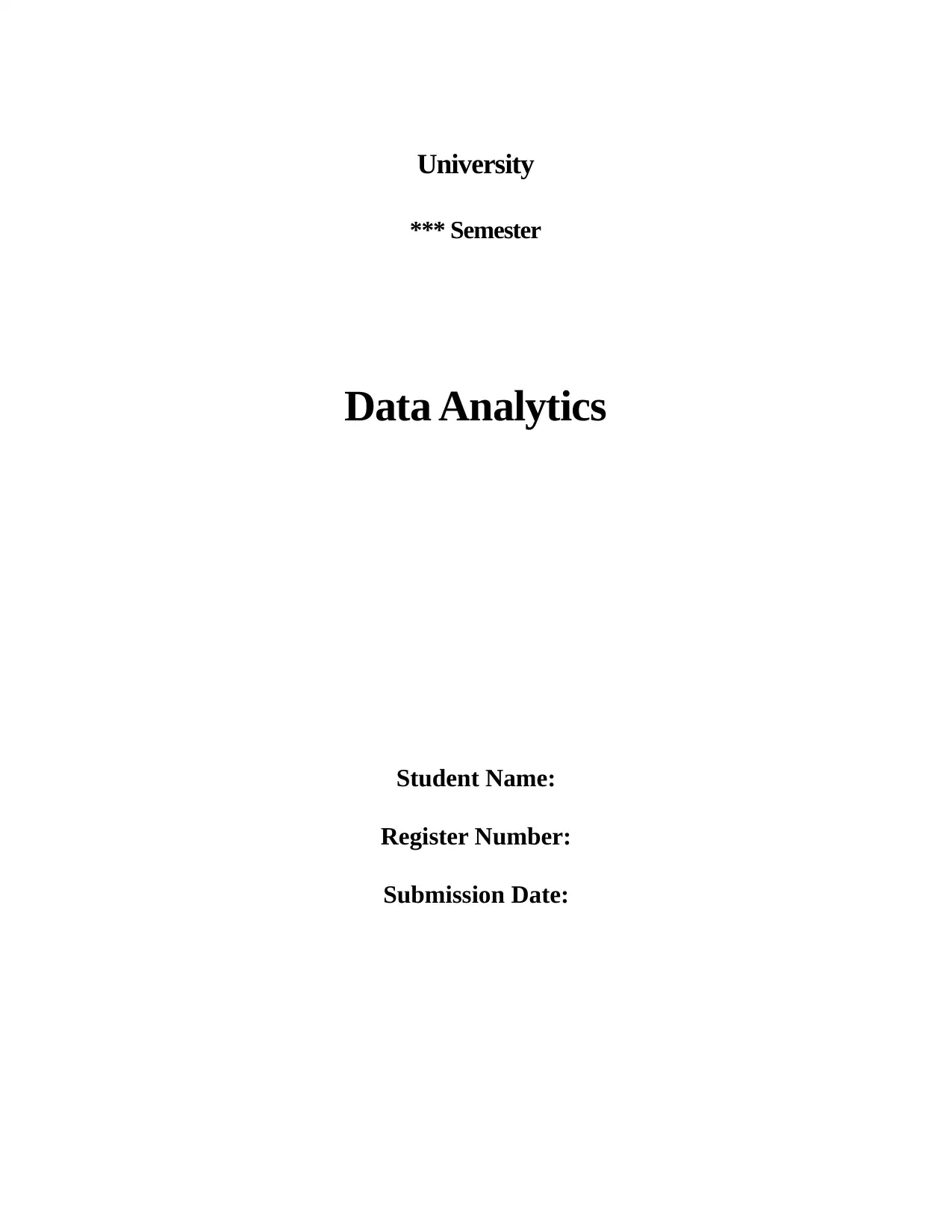
*** Semester
Data Analytics
Student Name:
Register Number:
Submission Date:
Paraphrase This Document
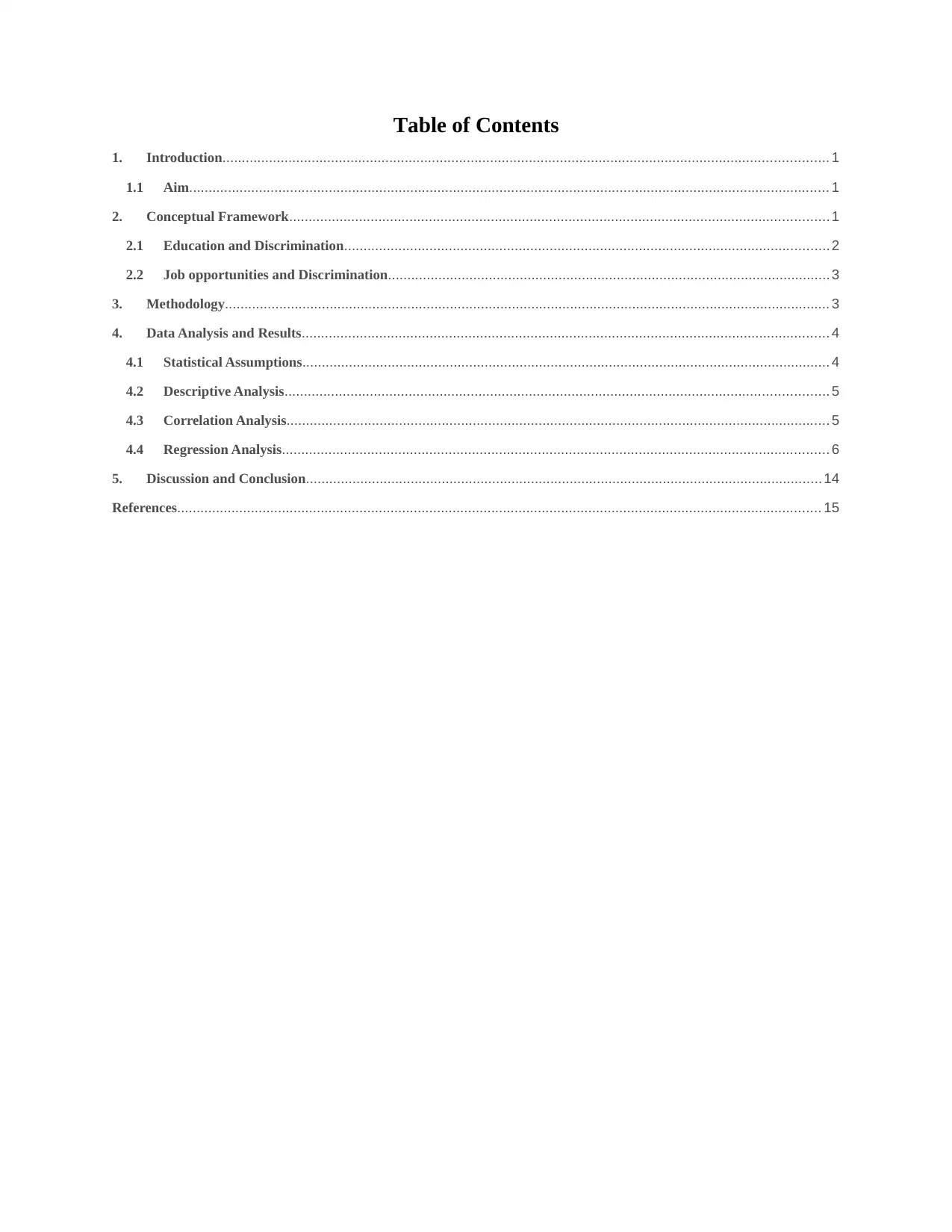
1. Introduction............................................................................................................................................................ 1
1.1 Aim..................................................................................................................................................................... 1
2. Conceptual Framework........................................................................................................................................... 1
2.1 Education and Discrimination.............................................................................................................................2
2.2 Job opportunities and Discrimination..................................................................................................................3
3. Methodology............................................................................................................................................................ 3
4. Data Analysis and Results........................................................................................................................................ 4
4.1 Statistical Assumptions........................................................................................................................................ 4
4.2 Descriptive Analysis............................................................................................................................................ 5
4.3 Correlation Analysis............................................................................................................................................ 5
4.4 Regression Analysis............................................................................................................................................. 6
5. Discussion and Conclusion..................................................................................................................................... 14
References...................................................................................................................................................................... 15

⊘ This is a preview!⊘
Do you want full access?
Subscribe today to unlock all pages.

Trusted by 1+ million students worldwide

This research revolves around the discrimination and their relationship with education
and job opportunities. In general, discrimination refers to an unfavorable treatment of an
individual in the public area of the life of public, because of the individual’s personal attributes.
For instance, discrimination occurs based on the gender, race, age, and disability. There are
various Acts which address the direct and indirect discriminations at work place. Similarly, one
example includes, the EO Act 2010. The direct discrimination refers to a situation, when an
individual treats another individual with a protected attribute unfavourably. Whereas, the indirect
discrimination refers to a cases, where an individual imposes unreasonable requirement,
condition or practice which can have impact on the individual (Equal Opportunity,
Discrimination and Harassment, 2018).
Here, education refers to the educational organizations and their student’s outcome on
studies, due to discrimination. Whereas, the job opportunities refer to corporate organizations
and their employee’s impact, due to discrimination.
The problem of this project includes, to determine the relation of education and job
opportunities with discrimination. This is a serious problem which need to be addressed, to save
the adolescence, youngsters and employees at work.
Hence, the objective of this report is to determine whether education and job
opportunities are positively or negatively related to discrimination. An appropriate research
methodology will be selected to carry out the research work.
1.1 Aim
The aim of this research is to find the relationship of education and job opportunities with
discrimination.
2. Conceptual Framework
This section reviews various research papers to find the relationships between the
independent and the dependent variables. The dependent variable is discrimination and the
independent variables are, education and job opportunities.
1
Paraphrase This Document
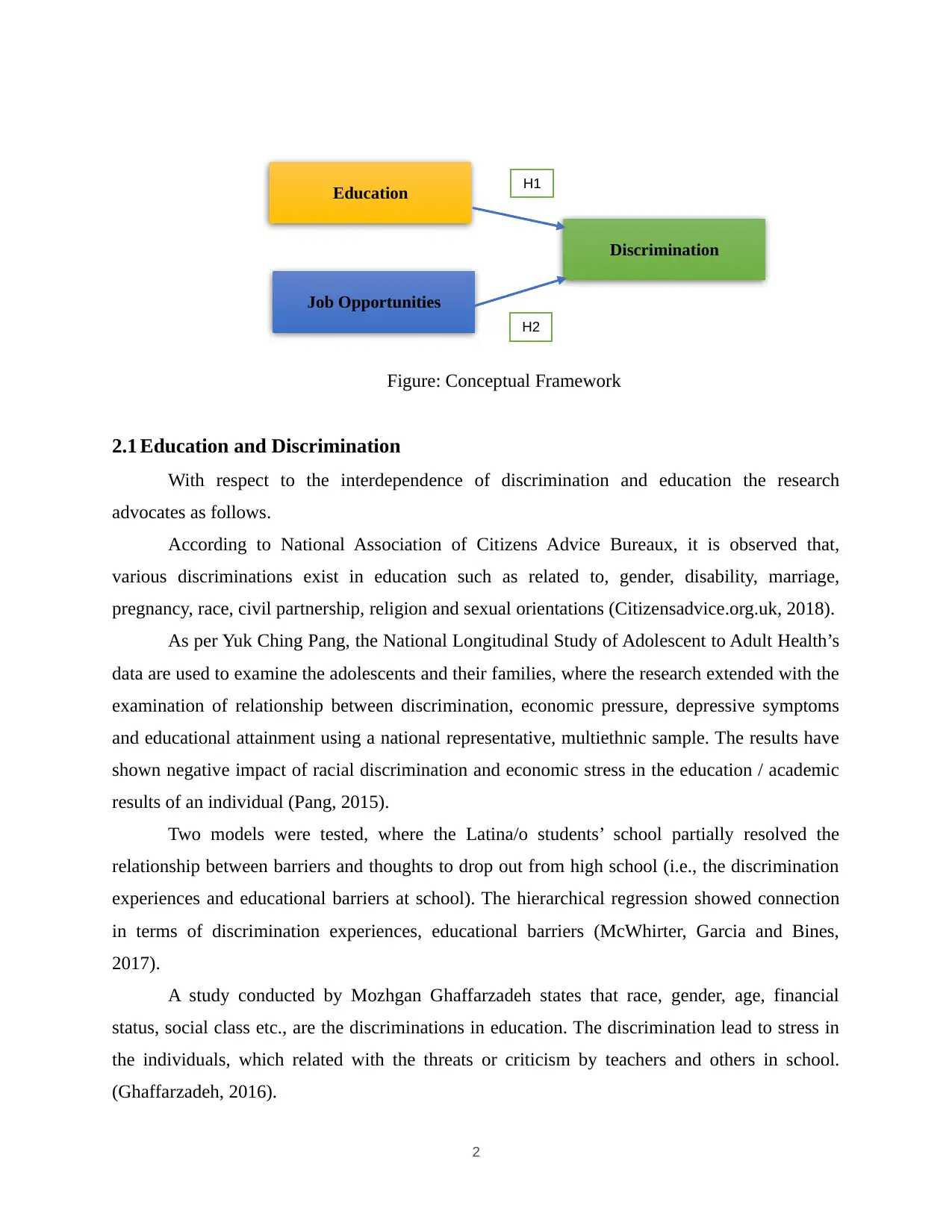
2.1 Education and Discrimination
With respect to the interdependence of discrimination and education the research
advocates as follows.
According to National Association of Citizens Advice Bureaux, it is observed that,
various discriminations exist in education such as related to, gender, disability, marriage,
pregnancy, race, civil partnership, religion and sexual orientations (Citizensadvice.org.uk, 2018).
As per Yuk Ching Pang, the National Longitudinal Study of Adolescent to Adult Health’s
data are used to examine the adolescents and their families, where the research extended with the
examination of relationship between discrimination, economic pressure, depressive symptoms
and educational attainment using a national representative, multiethnic sample. The results have
shown negative impact of racial discrimination and economic stress in the education / academic
results of an individual (Pang, 2015).
Two models were tested, where the Latina/o students’ school partially resolved the
relationship between barriers and thoughts to drop out from high school (i.e., the discrimination
experiences and educational barriers at school). The hierarchical regression showed connection
in terms of discrimination experiences, educational barriers (McWhirter, Garcia and Bines,
2017).
A study conducted by Mozhgan Ghaffarzadeh states that race, gender, age, financial
status, social class etc., are the discriminations in education. The discrimination lead to stress in
the individuals, which related with the threats or criticism by teachers and others in school.
(Ghaffarzadeh, 2016).
2
Education
Job Opportunities
Discrimination
H1
H2

education, the researcher Stuart Tannock has observed extensive discrimination in education.
From the data of schools, state and media it is proclaimed that inequality exists and it is
ridiculous, which results in injustice (Tannock, 2008).
Based on the above correlation between discrimination and education, the initial research
hypothesis is determined and presented below.
Hypothesis 1: Education is positively related to discrimination.
2.2 Job opportunities and Discrimination
Next, with respect to the interdependence of discrimination and job opportunities the
research advocates the following.
A discrimination study by, (Jang, Chiriboga, & Small, 2008; Miller & Kaiser, 2001) noted
that, the discrimination induces stress, prevents accessing the opportunities and impacts on the
interpersonal relationships. The research on the discrimination against gays and lesbians in the
workplace was conducted and showed that despite of effective rights and policies, the coworkers
and unsupportive management resulted in discrimination harming the access to job opportunities
(Marafuga et al., 2017).
The meta-analysis and two complementary empirical studies were conducted, to show a
relative deprivation theory, for examining the relationship between the employees’ perceptions
on gender discrimination and results, at work. When it comes to gender discrimination, the
results showed extreme impact on the employees at workplace (Triana et al., 2018).
Thus, based on the above correlation between the discrimination and education, the next
research hypothesis is determined and presented below.
Hypothesis 2: Job opportunities are positively related to discrimination.
3. Methodology
For any research work or taking the business decisions, gathering information or data is
the major task, as it helps to take better decisions. The methodology comprises of publication
research, surveys, interviews and various other research methods.
For data collection, the quantitative research method is utilized. Because, this method
looks for measurable and observable data on the variables. Additionally, it takes the secondary
3
⊘ This is a preview!⊘
Do you want full access?
Subscribe today to unlock all pages.

Trusted by 1+ million students worldwide
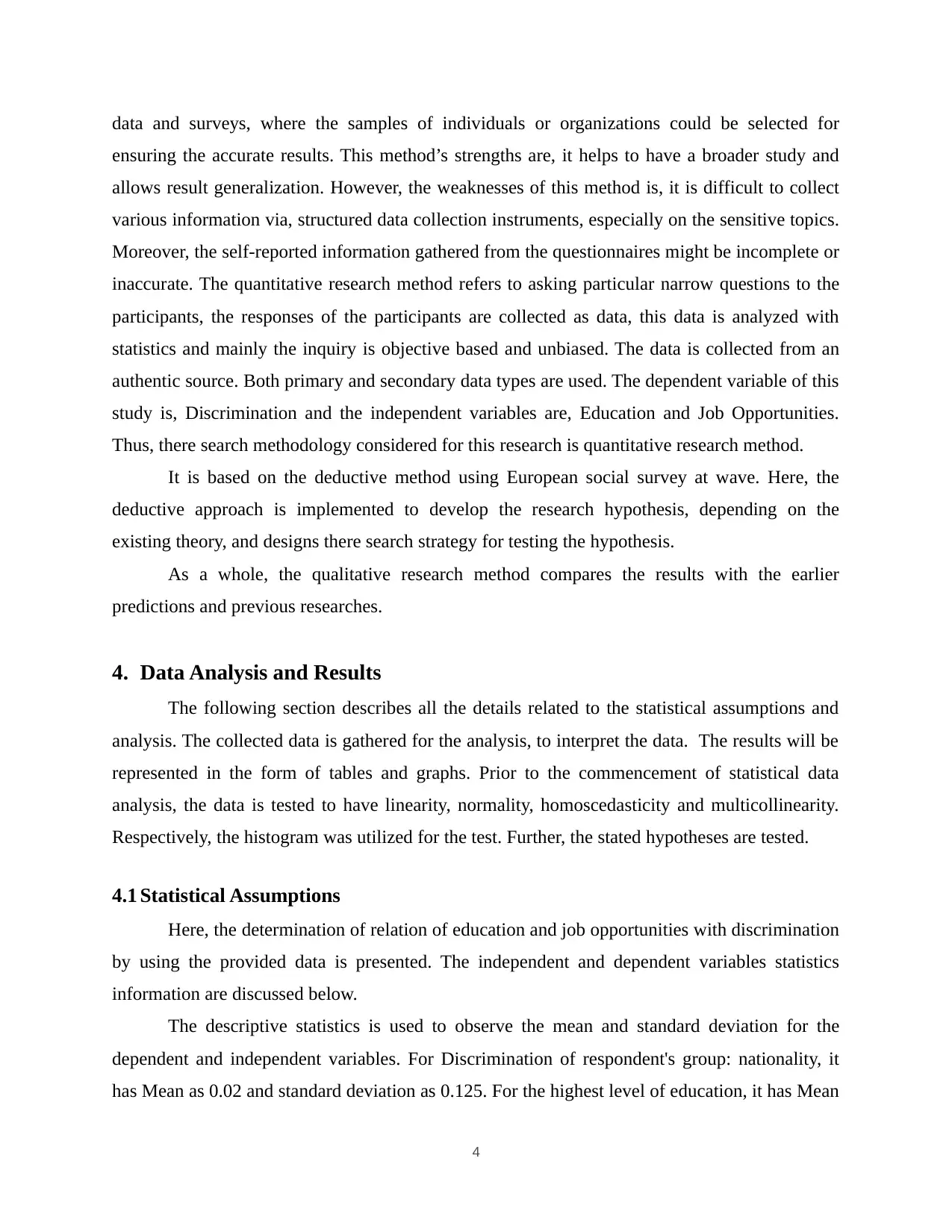
ensuring the accurate results. This method’s strengths are, it helps to have a broader study and
allows result generalization. However, the weaknesses of this method is, it is difficult to collect
various information via, structured data collection instruments, especially on the sensitive topics.
Moreover, the self-reported information gathered from the questionnaires might be incomplete or
inaccurate. The quantitative research method refers to asking particular narrow questions to the
participants, the responses of the participants are collected as data, this data is analyzed with
statistics and mainly the inquiry is objective based and unbiased. The data is collected from an
authentic source. Both primary and secondary data types are used. The dependent variable of this
study is, Discrimination and the independent variables are, Education and Job Opportunities.
Thus, there search methodology considered for this research is quantitative research method.
It is based on the deductive method using European social survey at wave. Here, the
deductive approach is implemented to develop the research hypothesis, depending on the
existing theory, and designs there search strategy for testing the hypothesis.
As a whole, the qualitative research method compares the results with the earlier
predictions and previous researches.
4. Data Analysis and Results
The following section describes all the details related to the statistical assumptions and
analysis. The collected data is gathered for the analysis, to interpret the data. The results will be
represented in the form of tables and graphs. Prior to the commencement of statistical data
analysis, the data is tested to have linearity, normality, homoscedasticity and multicollinearity.
Respectively, the histogram was utilized for the test. Further, the stated hypotheses are tested.
4.1 Statistical Assumptions
Here, the determination of relation of education and job opportunities with discrimination
by using the provided data is presented. The independent and dependent variables statistics
information are discussed below.
The descriptive statistics is used to observe the mean and standard deviation for the
dependent and independent variables. For Discrimination of respondent's group: nationality, it
has Mean as 0.02 and standard deviation as 0.125. For the highest level of education, it has Mean
4
Paraphrase This Document
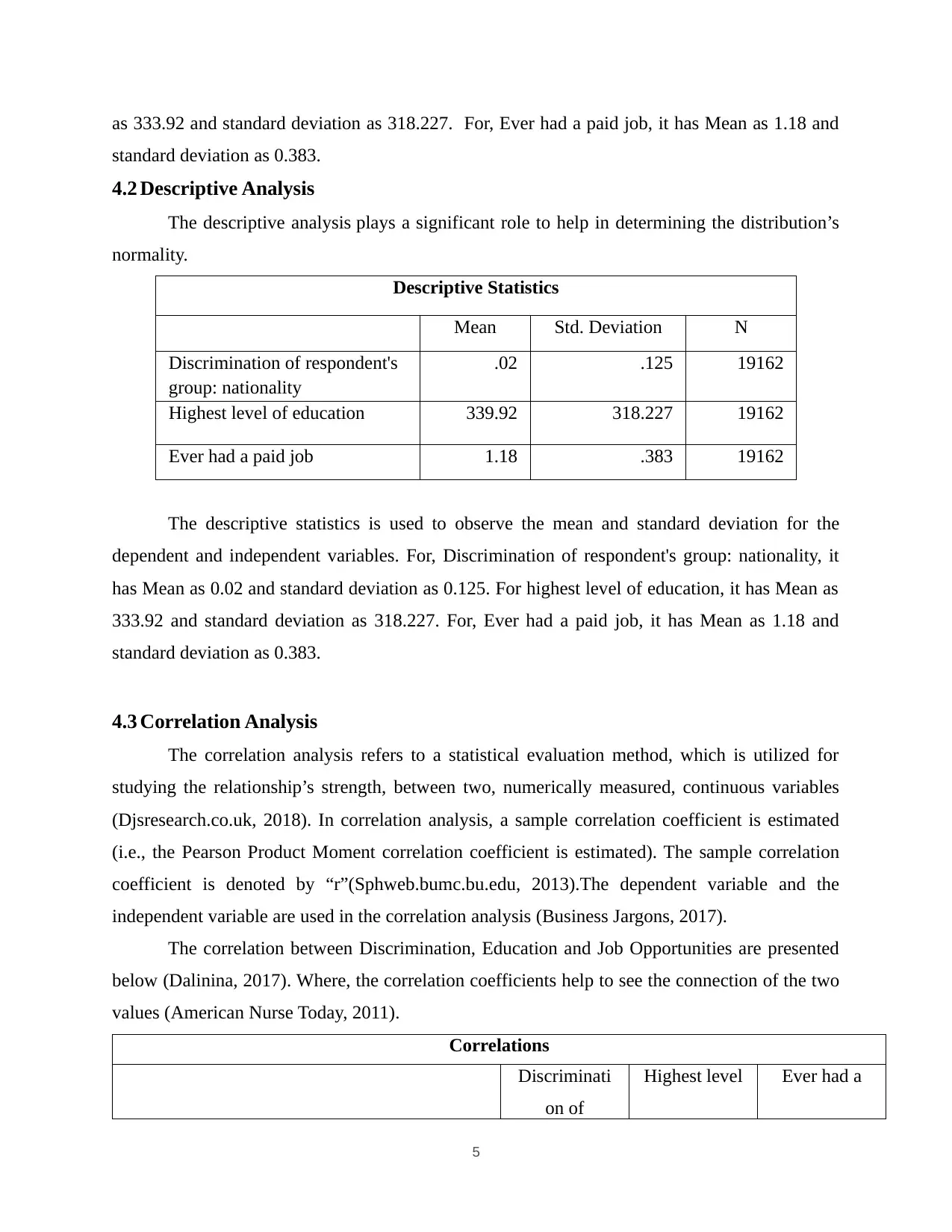
standard deviation as 0.383.
4.2 Descriptive Analysis
The descriptive analysis plays a significant role to help in determining the distribution’s
normality.
Descriptive Statistics
Mean Std. Deviation N
Discrimination of respondent's
group: nationality
.02 .125 19162
Highest level of education 339.92 318.227 19162
Ever had a paid job 1.18 .383 19162
The descriptive statistics is used to observe the mean and standard deviation for the
dependent and independent variables. For, Discrimination of respondent's group: nationality, it
has Mean as 0.02 and standard deviation as 0.125. For highest level of education, it has Mean as
333.92 and standard deviation as 318.227. For, Ever had a paid job, it has Mean as 1.18 and
standard deviation as 0.383.
4.3 Correlation Analysis
The correlation analysis refers to a statistical evaluation method, which is utilized for
studying the relationship’s strength, between two, numerically measured, continuous variables
(Djsresearch.co.uk, 2018). In correlation analysis, a sample correlation coefficient is estimated
(i.e., the Pearson Product Moment correlation coefficient is estimated). The sample correlation
coefficient is denoted by “r”(Sphweb.bumc.bu.edu, 2013).The dependent variable and the
independent variable are used in the correlation analysis (Business Jargons, 2017).
The correlation between Discrimination, Education and Job Opportunities are presented
below (Dalinina, 2017). Where, the correlation coefficients help to see the connection of the two
values (American Nurse Today, 2011).
Correlations
Discriminati
on of
Highest level Ever had a
5
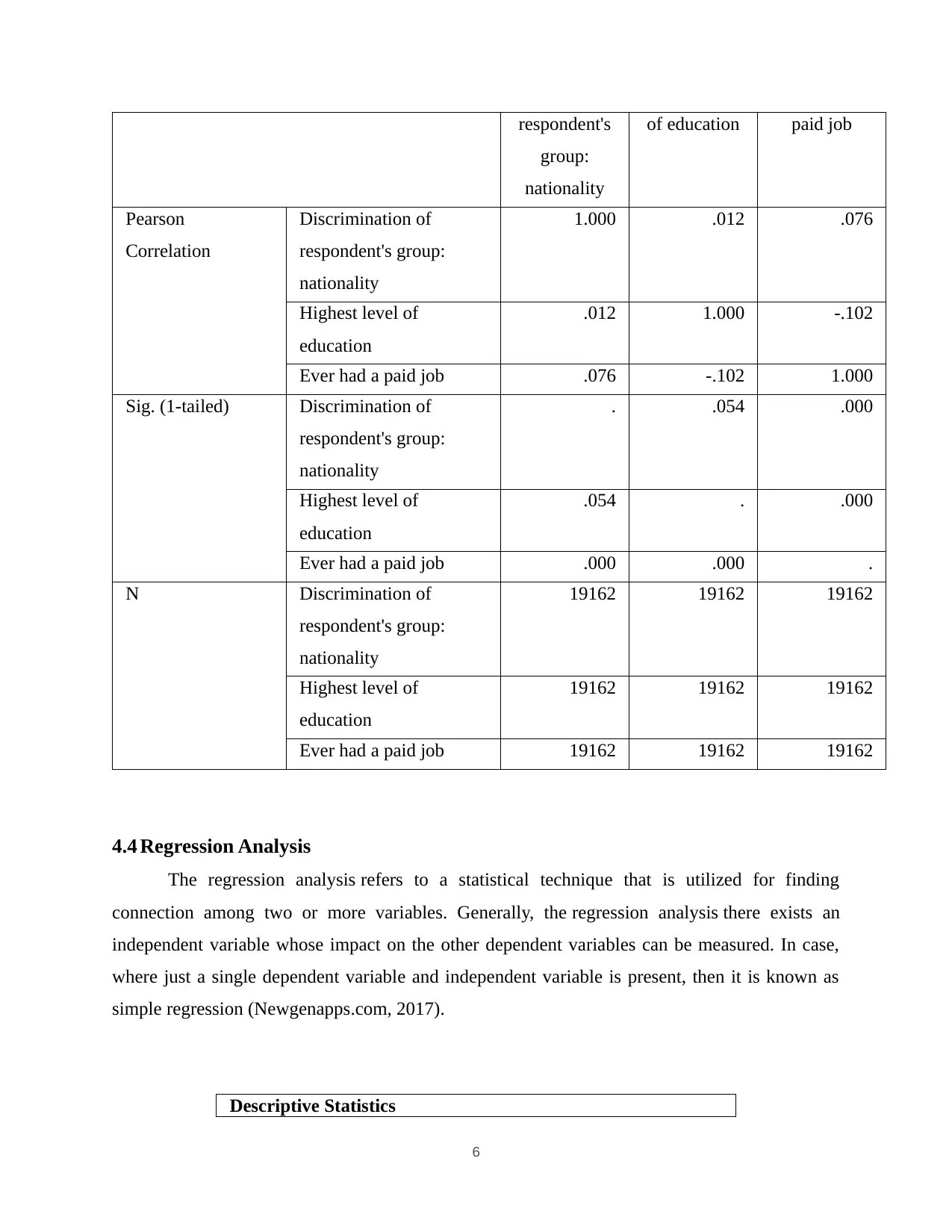
group:
nationality
of education paid job
Pearson
Correlation
Discrimination of
respondent's group:
nationality
1.000 .012 .076
Highest level of
education
.012 1.000 -.102
Ever had a paid job .076 -.102 1.000
Sig. (1-tailed) Discrimination of
respondent's group:
nationality
. .054 .000
Highest level of
education
.054 . .000
Ever had a paid job .000 .000 .
N Discrimination of
respondent's group:
nationality
19162 19162 19162
Highest level of
education
19162 19162 19162
Ever had a paid job 19162 19162 19162
4.4 Regression Analysis
The regression analysis refers to a statistical technique that is utilized for finding
connection among two or more variables. Generally, the regression analysis there exists an
independent variable whose impact on the other dependent variables can be measured. In case,
where just a single dependent variable and independent variable is present, then it is known as
simple regression (Newgenapps.com, 2017).
Descriptive Statistics
6
⊘ This is a preview!⊘
Do you want full access?
Subscribe today to unlock all pages.

Trusted by 1+ million students worldwide
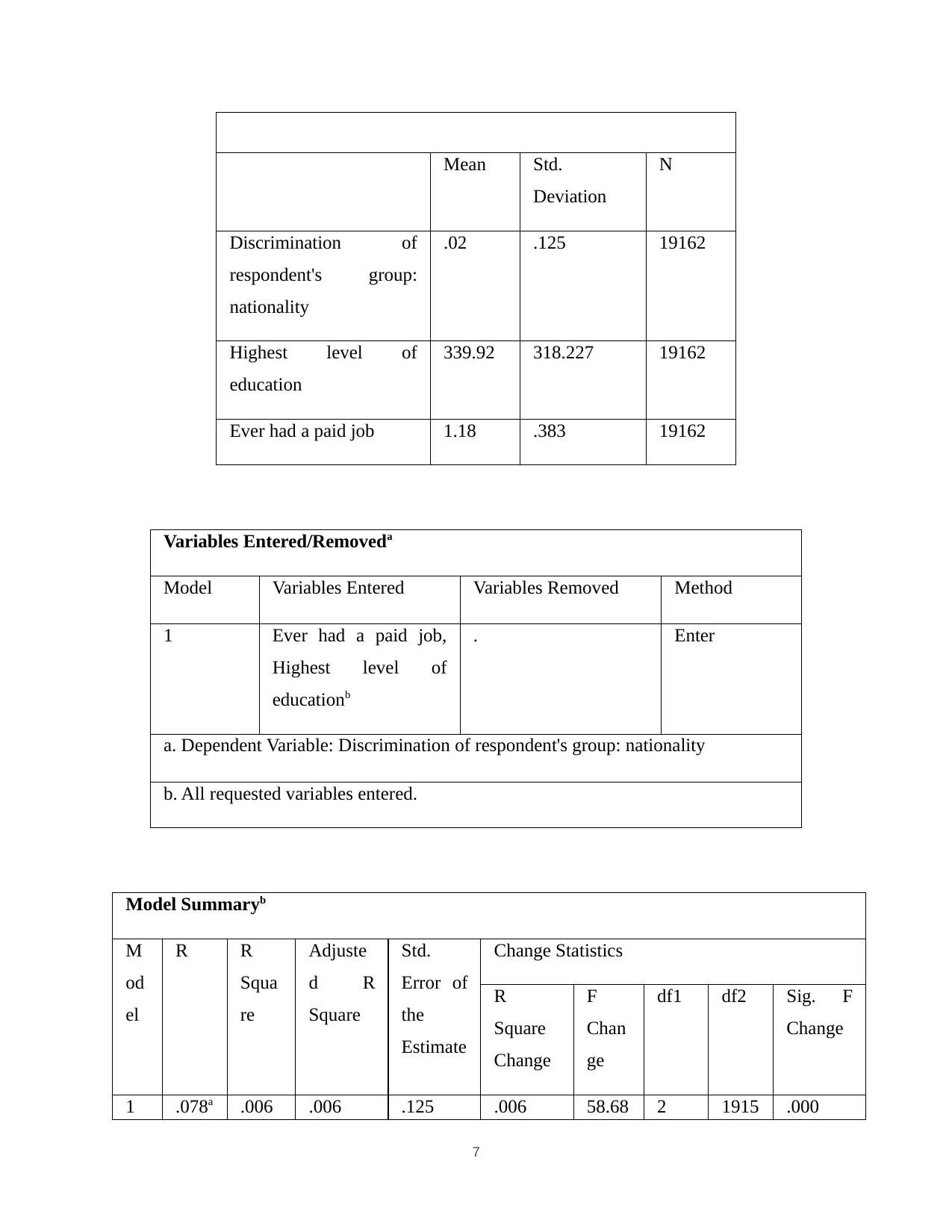
Deviation
N
Discrimination of
respondent's group:
nationality
.02 .125 19162
Highest level of
education
339.92 318.227 19162
Ever had a paid job 1.18 .383 19162
Variables Entered/Removeda
Model Variables Entered Variables Removed Method
1 Ever had a paid job,
Highest level of
educationb
. Enter
a. Dependent Variable: Discrimination of respondent's group: nationality
b. All requested variables entered.
Model Summaryb
M
od
el
R R
Squa
re
Adjuste
d R
Square
Std.
Error of
the
Estimate
Change Statistics
R
Square
Change
F
Chan
ge
df1 df2 Sig. F
Change
1 .078a .006 .006 .125 .006 58.68 2 1915 .000
7
Paraphrase This Document
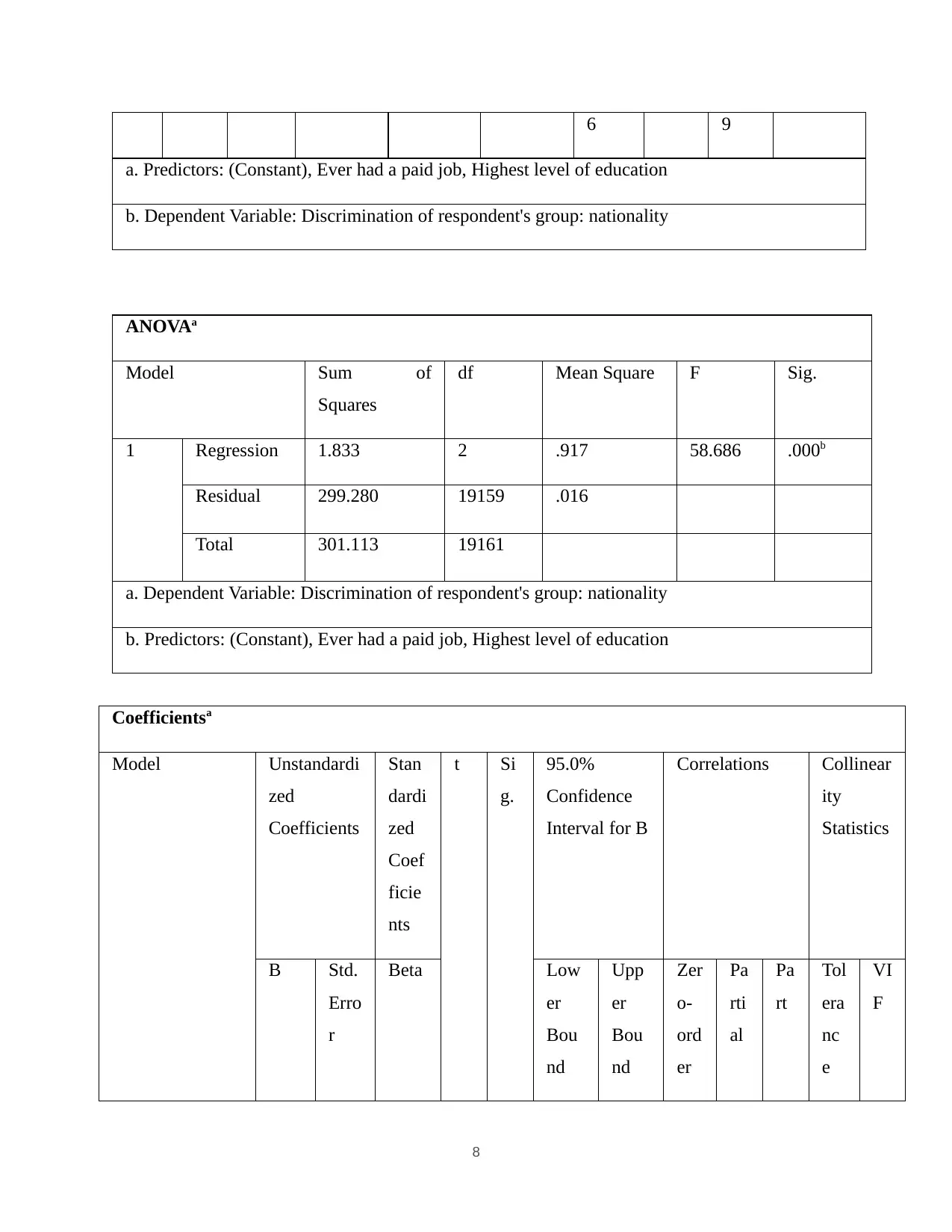
a. Predictors: (Constant), Ever had a paid job, Highest level of education
b. Dependent Variable: Discrimination of respondent's group: nationality
ANOVAa
Model Sum of
Squares
df Mean Square F Sig.
1 Regression 1.833 2 .917 58.686 .000b
Residual 299.280 19159 .016
Total 301.113 19161
a. Dependent Variable: Discrimination of respondent's group: nationality
b. Predictors: (Constant), Ever had a paid job, Highest level of education
Coefficientsa
Model Unstandardi
zed
Coefficients
Stan
dardi
zed
Coef
ficie
nts
t Si
g.
95.0%
Confidence
Interval for B
Correlations Collinear
ity
Statistics
B Std.
Erro
r
Beta Low
er
Bou
nd
Upp
er
Bou
nd
Zer
o-
ord
er
Pa
rti
al
Pa
rt
Tol
era
nc
e
VI
F
8
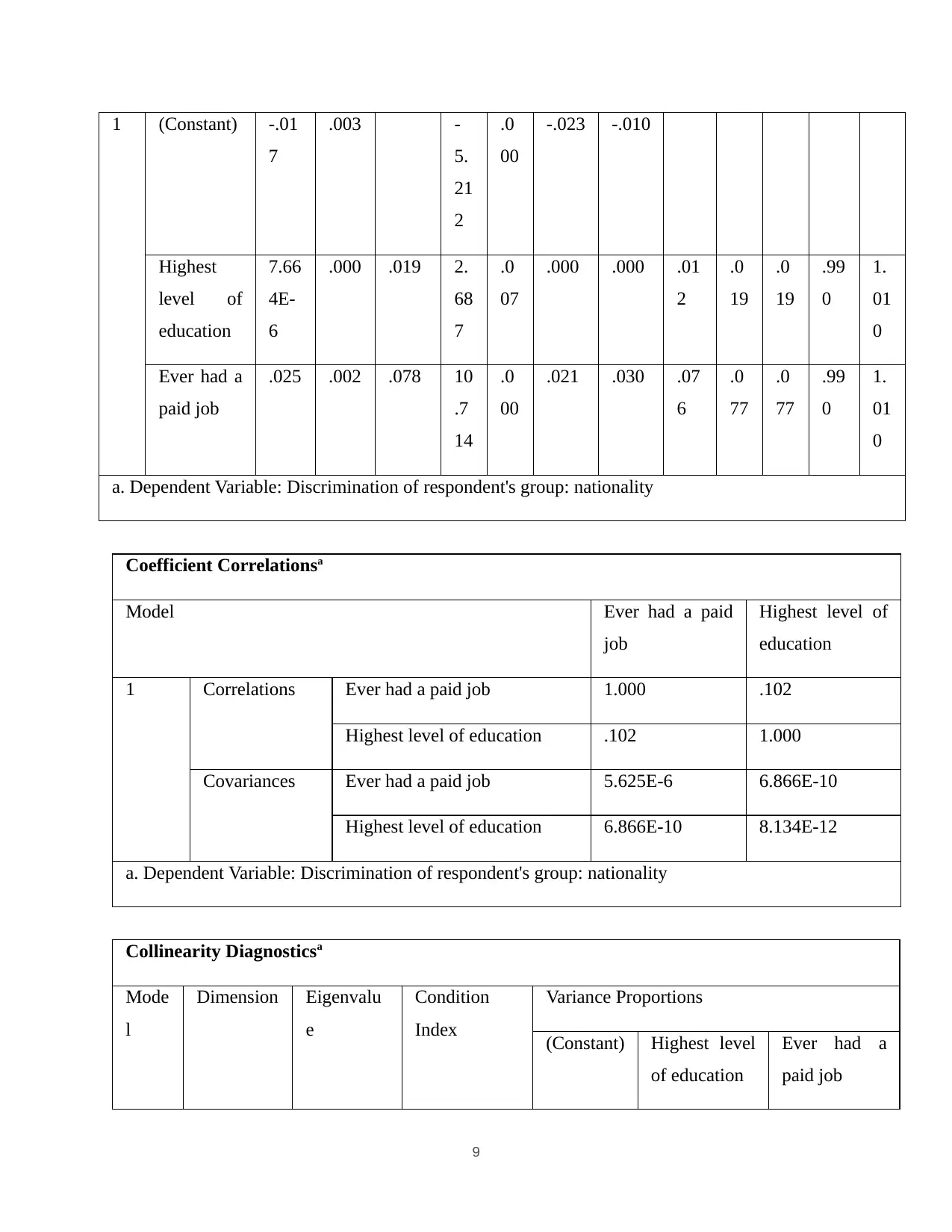
7
.003 -
5.
21
2
.0
00
-.023 -.010
Highest
level of
education
7.66
4E-
6
.000 .019 2.
68
7
.0
07
.000 .000 .01
2
.0
19
.0
19
.99
0
1.
01
0
Ever had a
paid job
.025 .002 .078 10
.7
14
.0
00
.021 .030 .07
6
.0
77
.0
77
.99
0
1.
01
0
a. Dependent Variable: Discrimination of respondent's group: nationality
Coefficient Correlationsa
Model Ever had a paid
job
Highest level of
education
1 Correlations Ever had a paid job 1.000 .102
Highest level of education .102 1.000
Covariances Ever had a paid job 5.625E-6 6.866E-10
Highest level of education 6.866E-10 8.134E-12
a. Dependent Variable: Discrimination of respondent's group: nationality
Collinearity Diagnosticsa
Mode
l
Dimension Eigenvalu
e
Condition
Index
Variance Proportions
(Constant) Highest level
of education
Ever had a
paid job
9
⊘ This is a preview!⊘
Do you want full access?
Subscribe today to unlock all pages.

Trusted by 1+ million students worldwide
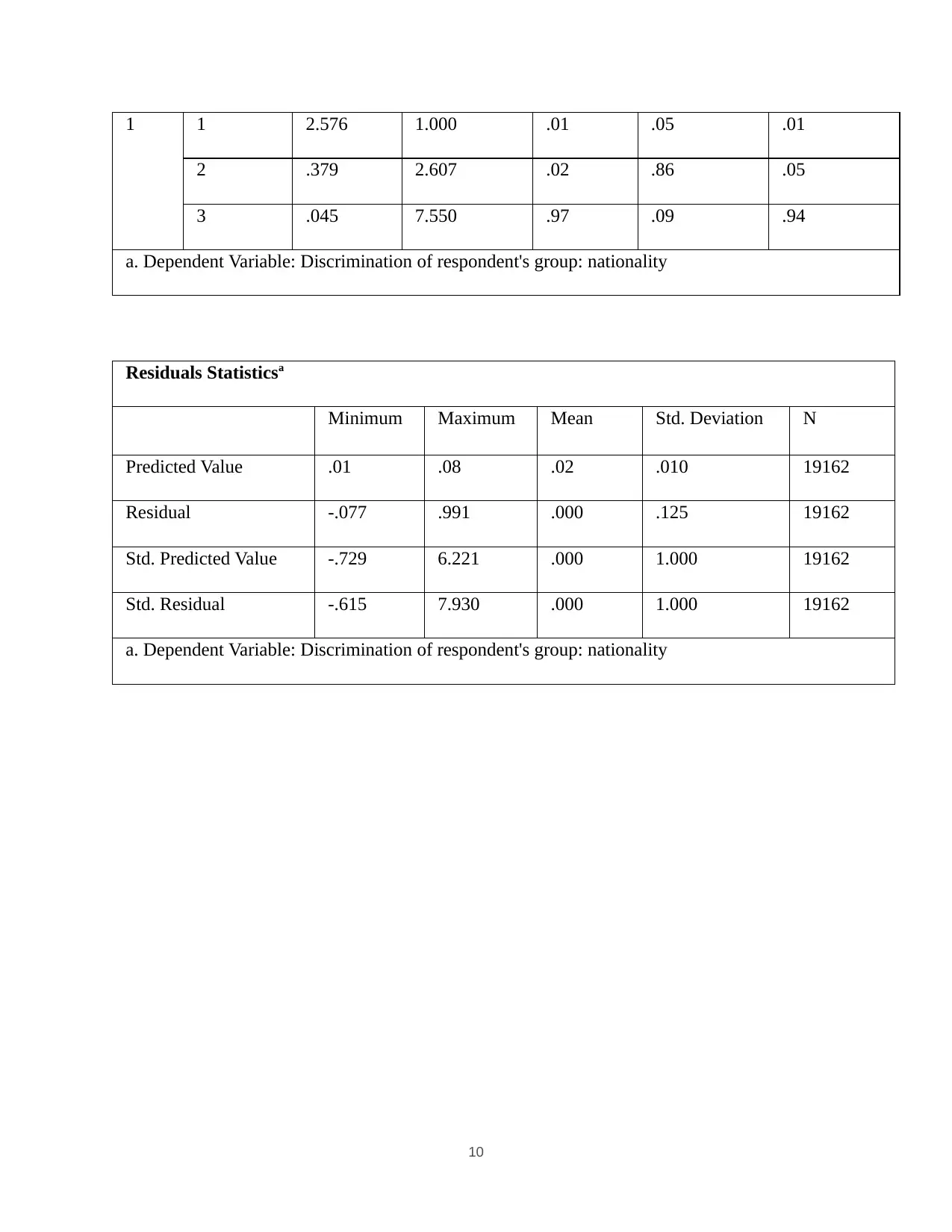
2 .379 2.607 .02 .86 .05
3 .045 7.550 .97 .09 .94
a. Dependent Variable: Discrimination of respondent's group: nationality
Residuals Statisticsa
Minimum Maximum Mean Std. Deviation N
Predicted Value .01 .08 .02 .010 19162
Residual -.077 .991 .000 .125 19162
Std. Predicted Value -.729 6.221 .000 1.000 19162
Std. Residual -.615 7.930 .000 1.000 19162
a. Dependent Variable: Discrimination of respondent's group: nationality
10
Paraphrase This Document
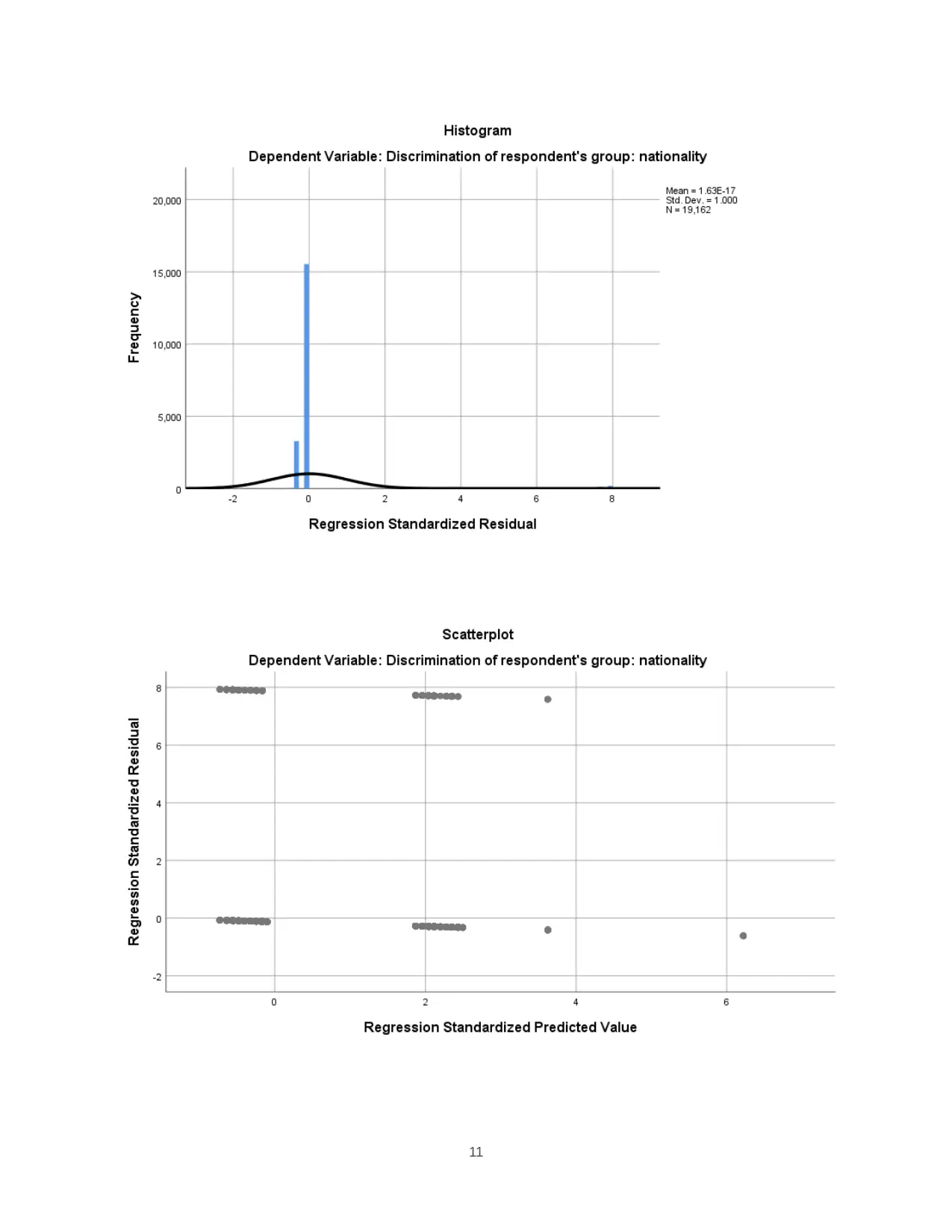
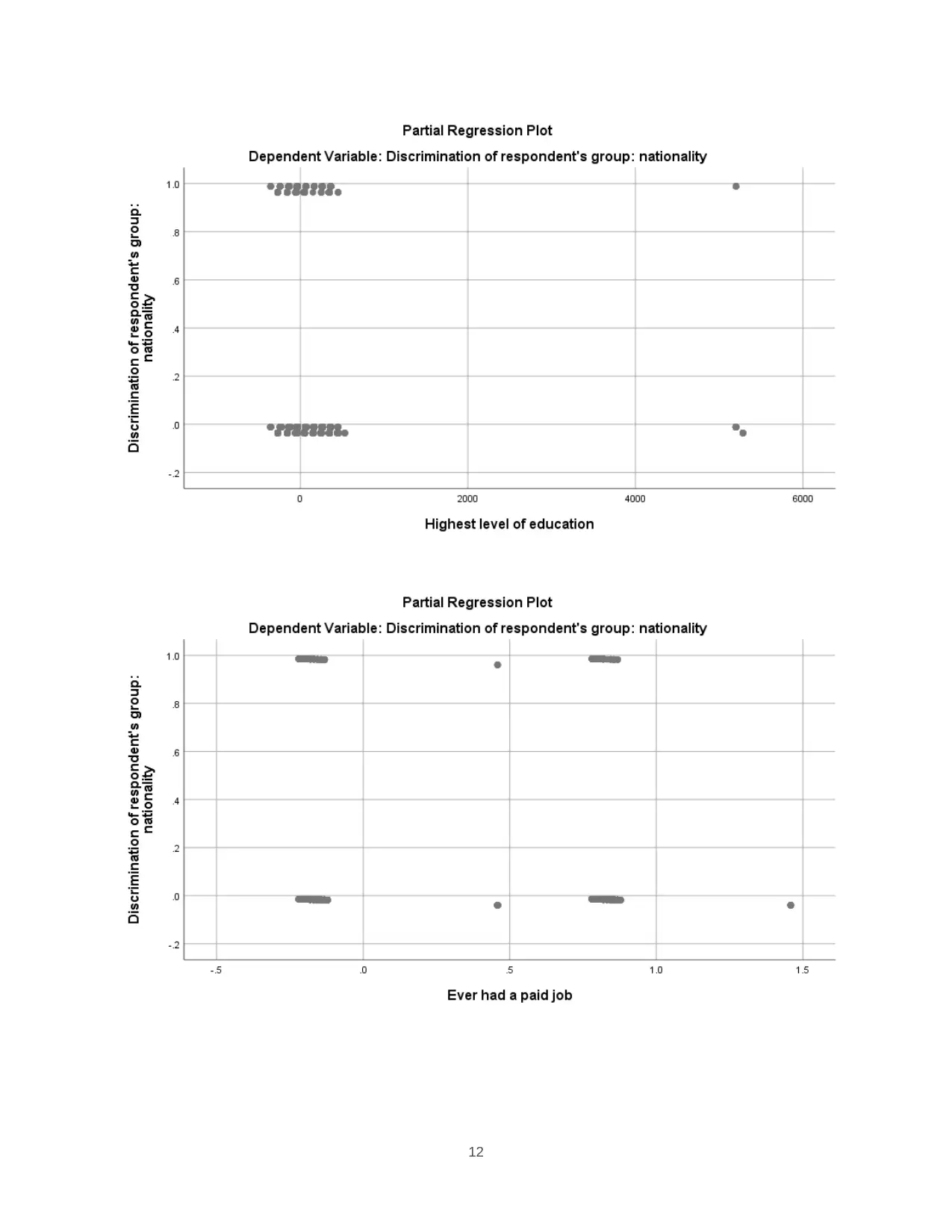
⊘ This is a preview!⊘
Do you want full access?
Subscribe today to unlock all pages.

Trusted by 1+ million students worldwide
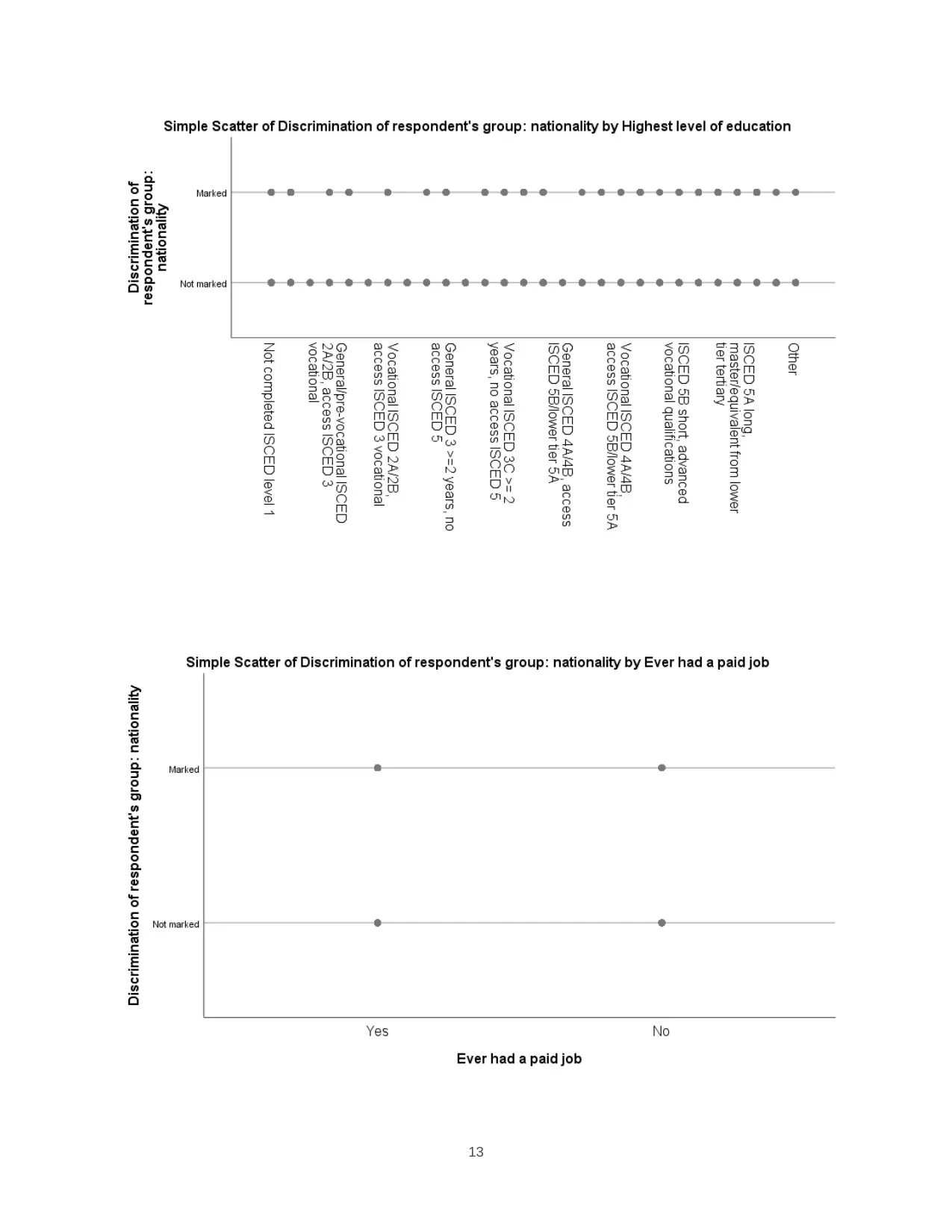
Paraphrase This Document
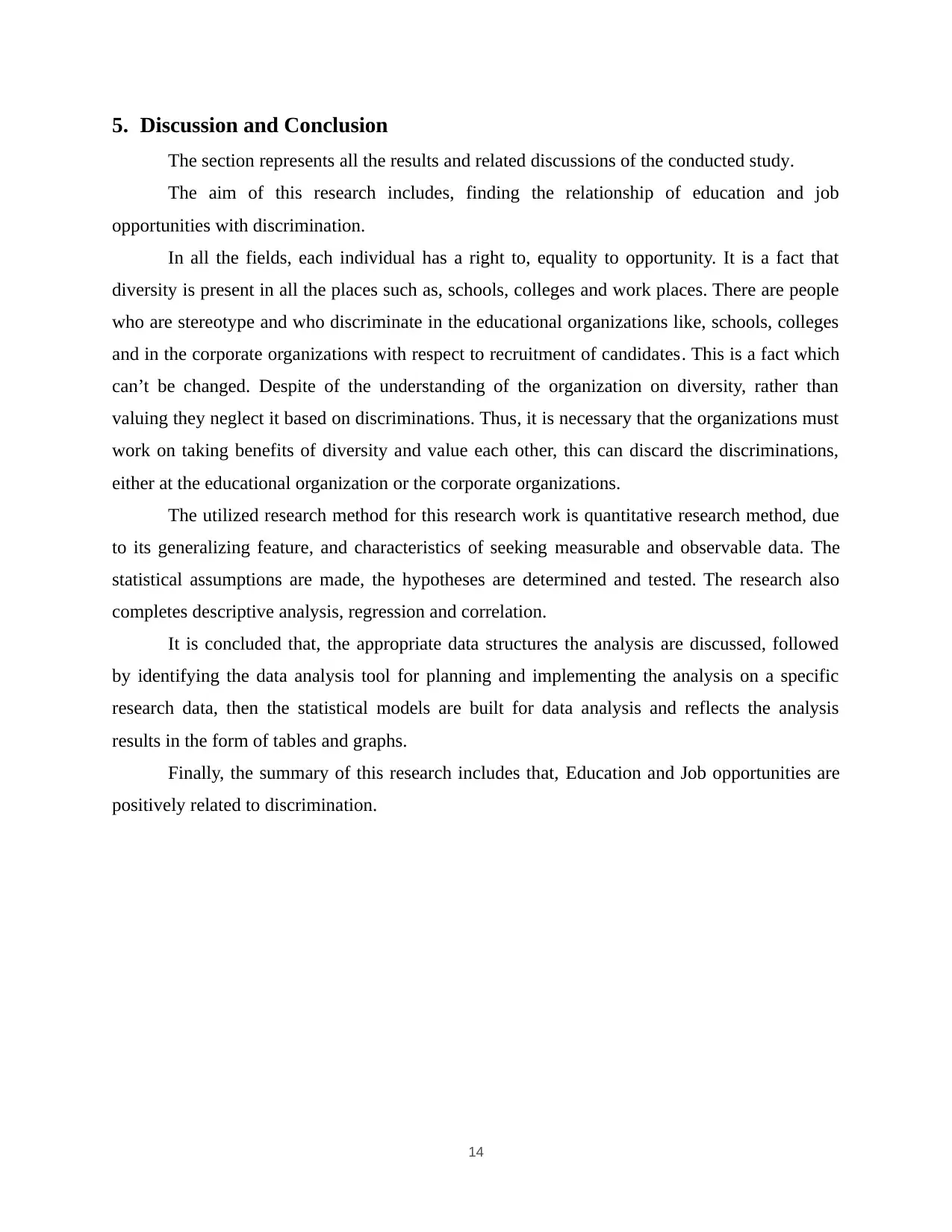
The section represents all the results and related discussions of the conducted study.
The aim of this research includes, finding the relationship of education and job
opportunities with discrimination.
In all the fields, each individual has a right to, equality to opportunity. It is a fact that
diversity is present in all the places such as, schools, colleges and work places. There are people
who are stereotype and who discriminate in the educational organizations like, schools, colleges
and in the corporate organizations with respect to recruitment of candidates. This is a fact which
can’t be changed. Despite of the understanding of the organization on diversity, rather than
valuing they neglect it based on discriminations. Thus, it is necessary that the organizations must
work on taking benefits of diversity and value each other, this can discard the discriminations,
either at the educational organization or the corporate organizations.
The utilized research method for this research work is quantitative research method, due
to its generalizing feature, and characteristics of seeking measurable and observable data. The
statistical assumptions are made, the hypotheses are determined and tested. The research also
completes descriptive analysis, regression and correlation.
It is concluded that, the appropriate data structures the analysis are discussed, followed
by identifying the data analysis tool for planning and implementing the analysis on a specific
research data, then the statistical models are built for data analysis and reflects the analysis
results in the form of tables and graphs.
Finally, the summary of this research includes that, Education and Job opportunities are
positively related to discrimination.
14
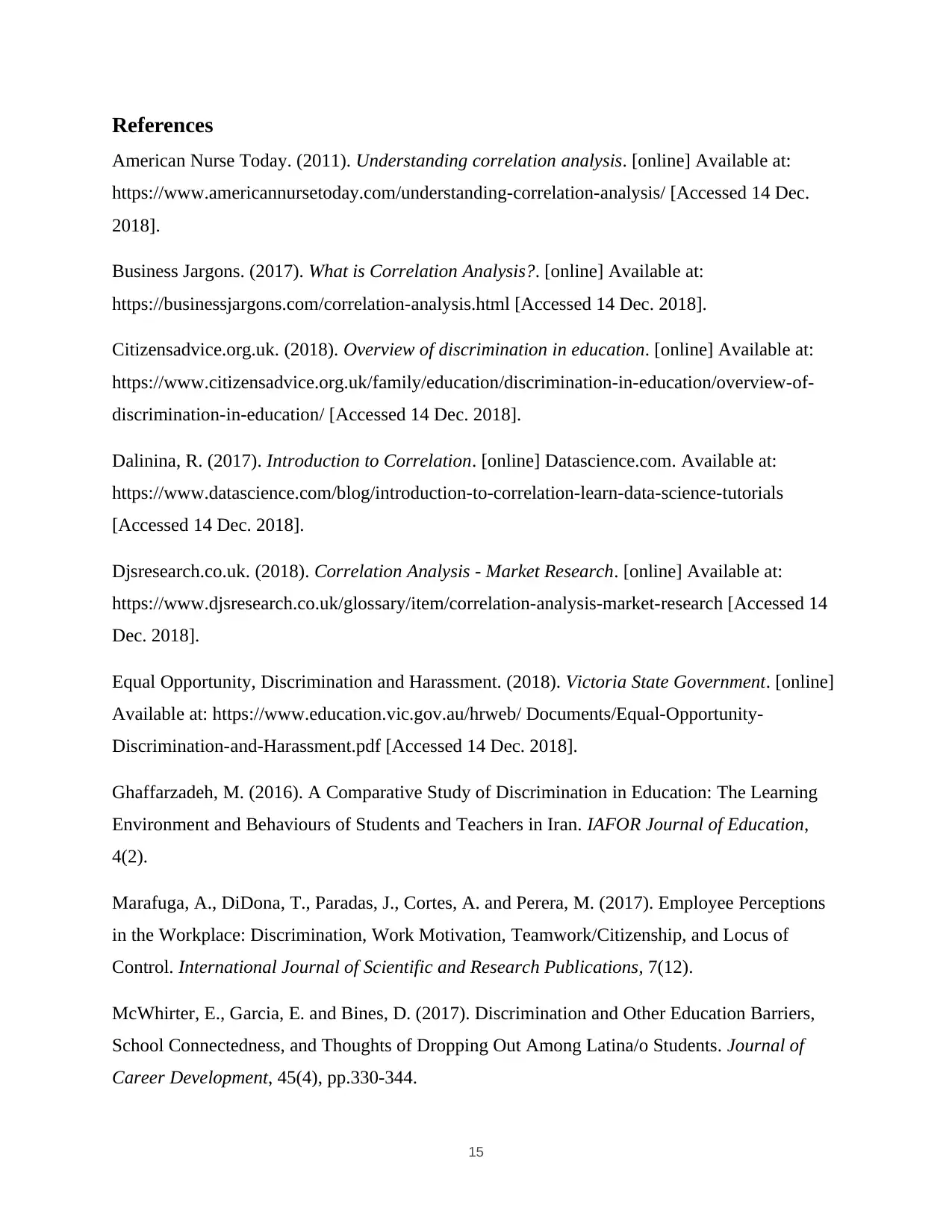
American Nurse Today. (2011). Understanding correlation analysis. [online] Available at:
https://www.americannursetoday.com/understanding-correlation-analysis/ [Accessed 14 Dec.
2018].
Business Jargons. (2017). What is Correlation Analysis?. [online] Available at:
https://businessjargons.com/correlation-analysis.html [Accessed 14 Dec. 2018].
Citizensadvice.org.uk. (2018). Overview of discrimination in education. [online] Available at:
https://www.citizensadvice.org.uk/family/education/discrimination-in-education/overview-of-
discrimination-in-education/ [Accessed 14 Dec. 2018].
Dalinina, R. (2017). Introduction to Correlation. [online] Datascience.com. Available at:
https://www.datascience.com/blog/introduction-to-correlation-learn-data-science-tutorials
[Accessed 14 Dec. 2018].
Djsresearch.co.uk. (2018). Correlation Analysis - Market Research. [online] Available at:
https://www.djsresearch.co.uk/glossary/item/correlation-analysis-market-research [Accessed 14
Dec. 2018].
Equal Opportunity, Discrimination and Harassment. (2018). Victoria State Government. [online]
Available at: https://www.education.vic.gov.au/hrweb/ Documents/Equal-Opportunity-
Discrimination-and-Harassment.pdf [Accessed 14 Dec. 2018].
Ghaffarzadeh, M. (2016). A Comparative Study of Discrimination in Education: The Learning
Environment and Behaviours of Students and Teachers in Iran. IAFOR Journal of Education,
4(2).
Marafuga, A., DiDona, T., Paradas, J., Cortes, A. and Perera, M. (2017). Employee Perceptions
in the Workplace: Discrimination, Work Motivation, Teamwork/Citizenship, and Locus of
Control. International Journal of Scientific and Research Publications, 7(12).
McWhirter, E., Garcia, E. and Bines, D. (2017). Discrimination and Other Education Barriers,
School Connectedness, and Thoughts of Dropping Out Among Latina/o Students. Journal of
Career Development, 45(4), pp.330-344.
15
⊘ This is a preview!⊘
Do you want full access?
Subscribe today to unlock all pages.

Trusted by 1+ million students worldwide
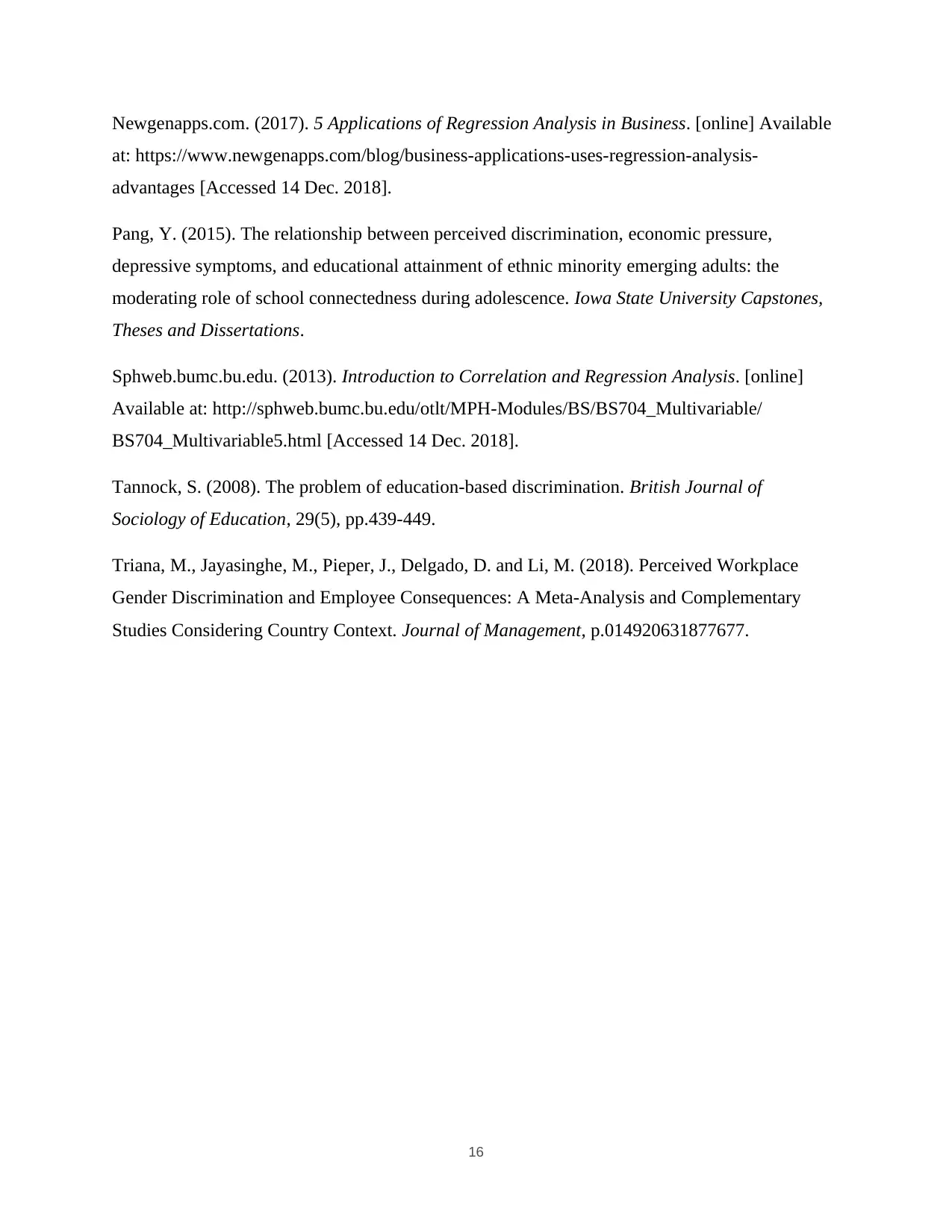
at: https://www.newgenapps.com/blog/business-applications-uses-regression-analysis-
advantages [Accessed 14 Dec. 2018].
Pang, Y. (2015). The relationship between perceived discrimination, economic pressure,
depressive symptoms, and educational attainment of ethnic minority emerging adults: the
moderating role of school connectedness during adolescence. Iowa State University Capstones,
Theses and Dissertations.
Sphweb.bumc.bu.edu. (2013). Introduction to Correlation and Regression Analysis. [online]
Available at: http://sphweb.bumc.bu.edu/otlt/MPH-Modules/BS/BS704_Multivariable/
BS704_Multivariable5.html [Accessed 14 Dec. 2018].
Tannock, S. (2008). The problem of education‐based discrimination. British Journal of
Sociology of Education, 29(5), pp.439-449.
Triana, M., Jayasinghe, M., Pieper, J., Delgado, D. and Li, M. (2018). Perceived Workplace
Gender Discrimination and Employee Consequences: A Meta-Analysis and Complementary
Studies Considering Country Context. Journal of Management, p.014920631877677.
16
Related Documents
Your All-in-One AI-Powered Toolkit for Academic Success.
+13062052269
info@desklib.com
Available 24*7 on WhatsApp / Email
![[object Object]](/_next/static/media/star-bottom.7253800d.svg)
© 2024 | Zucol Services PVT LTD | All rights reserved.





